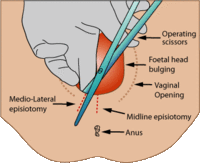
Photo from wikipedia
OBJECTIVES To compare the effectiveness of pharmacological (PT) and nonpharmacological treatments (NPT) in women with primary dysmenorrhea (PD) and determine the most effective treatment method. MATERIAL AND METHODS We enrolled… Click to show full abstract
OBJECTIVES To compare the effectiveness of pharmacological (PT) and nonpharmacological treatments (NPT) in women with primary dysmenorrhea (PD) and determine the most effective treatment method. MATERIAL AND METHODS We enrolled 85 PD participants with PD who were randomly classified into five groups: pharmacological groups; naproxen sodium (NS) and micronized purified flavanoid fraction (MPFF), nonpharmacological groups; motor imagery focused pelvic floor exercise (MOPEXE) and acupressure, and no treatment group; control. Initial assessment was conducted in all groups on the first day of the menstrual cycle. After the end ofthe third menstrual cycle, the specialist physiotherapist and the obstetrician conducted a final evaluation. Intensity and nature of pain were evaluated with the Short-Form McGill Pain Questionnaire (SF-MPQ), and menstrual attitudes and behaviors were evaluated using the Menstruation Attitude Questionnaire (MAQ). RESULTS In the total pain dimension scores, which are the sum of the affective dimension of pain and sensory dimension scores, the pre-post treatment difference was the highest in the mean of the total pain dimension. The highest was for MOPEXE (15.12 ± 4.44), followed by MPFF (7.53 ± 6.8); acupressure (7.47 ± 5.28) and NS (4.47 ± 4.91) showed more significant change than the control group (p = 0.001). The mean difference in visual analog scale (VAS) scores was highest in MOPEXE (4.53 ± 1.5), followed by acupressure (2.35 ± 1.66); MPFF (1.88 ± 1.73) and NS (1.65 ± 1.84) scores were more significant than the control group (p = 0.001). Regarding total pain intensity, the highest was MOPEXE (2.59 ± 0.94), followed by MPFF (1.18 ± 0.88); acupressure (1.06 ± 0.83) and NS (0.82 ± 1.01) scores were more significant compared to the control group (p = 0.001). There was no significant change in the pre-post difference values in the MAQ subparameters: menstruation as deliberate event, menstruating as bothersome event, menstruation as natural event, anticipation and prediction of the onset of menstruation, and denial of any effects of menstruation; menstruation as a natural event resulted in insignificant changes in parameters (p = 0.579, p = 0.074, p = 0.892, p = 0.056, p = 0. 377). CONCLUSIONS PT and NPT methods in the study were effective in coping with PD-associated pain. MPFF was more effective than the NS group in terms of relieving pain. In terms of pain, MOPEXE and acupressure groups were as effective as PT. The most effective of these treatment methods was the MOPEXE group created by the researcher.
Journal Title: Ginekologia polska
Year Published: 2022
Link to full text (if available)
Share on Social Media: Sign Up to like & get
recommendations!